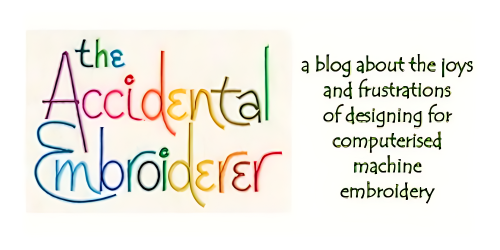Something new – the woolly sheep
I know it’s ungrateful of me but I’m getting a bit bored with doing all these commissions. The problem is that either they’re not very ambitious ideas, or they’re based on old designs of mine that I’ve stitched hundreds of times. So I’m taking a break and trying out some new ideas.
Ever since I tried the photo facility on the Innovis-i I’ve wanted to play around with it some more, and I’ve also wanted for some time to find a way of combining embellishing (needle-felting with a machine) with digitised embroidery. So here’s an idea that uses both these techniques.
I did a rough drawing of a sheep and digitised it quickly. It is intended to be made in three stages: the first embroidery stage, the embellishing, and the final embroidery stage. Here’s the first embroidery stage
The head and legs are stitched first, and then a guide line is stitched, which will help with the placement of the felted wool at the next stage.
The sheep after the wool is felted on
Then for the second stage the embroidery is removed from the hoop and strands of wool are felted on with the embellishing machine. Then the wool is trimmed and the embroidery is re-hooped. At this stage you need the camera facility on the machine to be sure that the embroidery pattern is aligned with the embroidery in the hoop. Finally the last steps of the embroidery are finished – the ear and the details of the woolly coat. It is VERY important to stitch these final details over a piece of water-soluble stabiliser to prevent any of the loops of wool from becoming caught up in the machine’s foot
The sheep after the final embroidered details are added
It's just a simple design but I'm pleased with the way it turned out. The techniques worked pretty well and should be applicable to other ideas besides sheep
